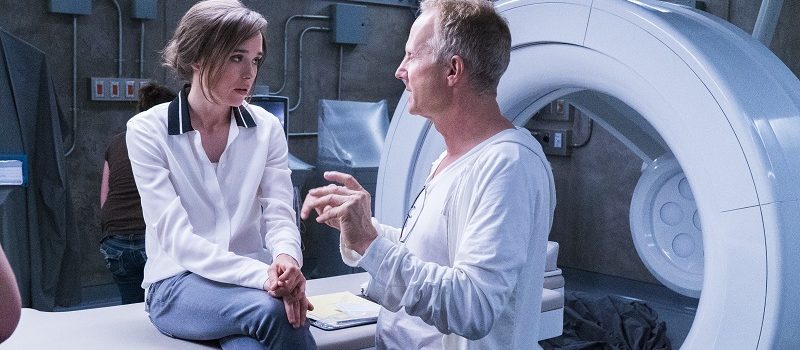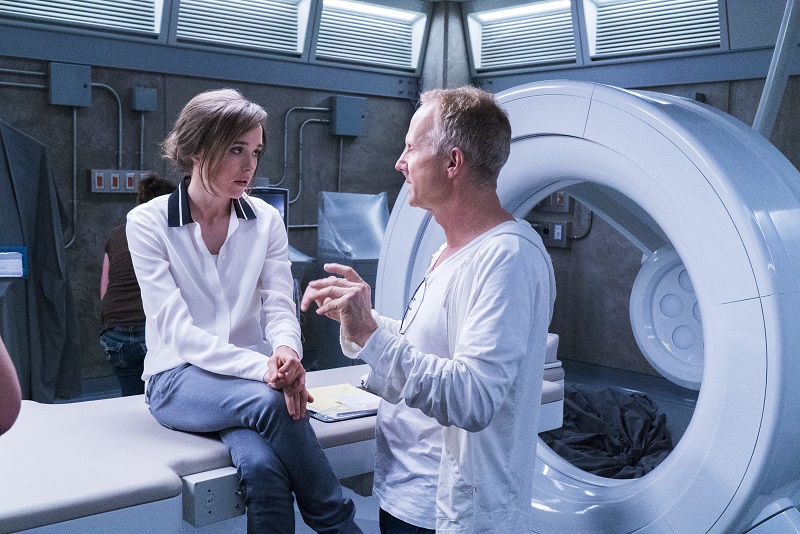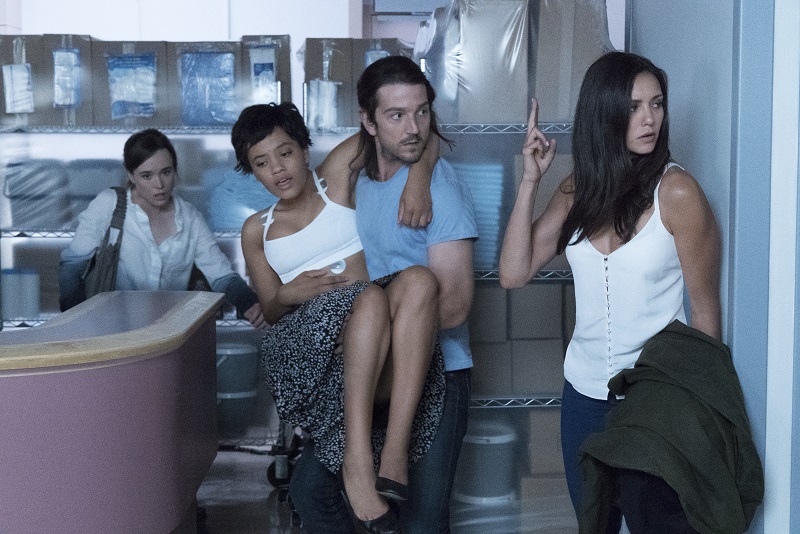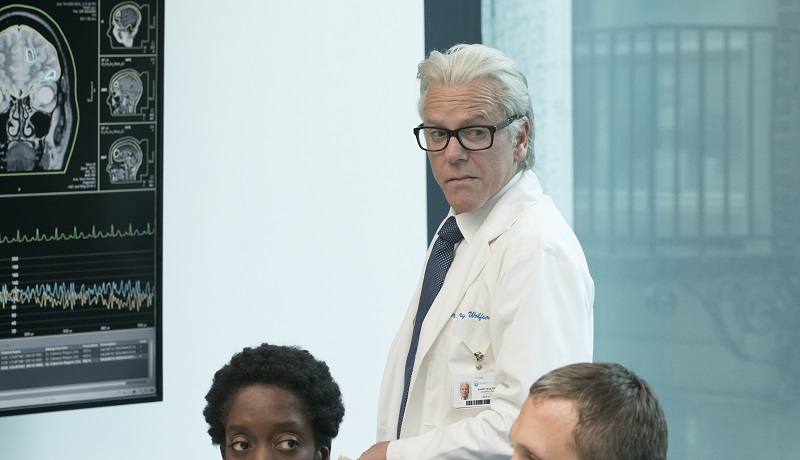Flatliners arrived in 1990 and became a hit that has evolved into a cult classic as the years have become decades. It starred Kiefer Sutherland, Julia Roberts, Kevin Bacon, Oliver Platt and William Baldwin. Besides striking a chord with its plot about a group of medical students who flatline to discover more scientifically about the act of death, it has resonated due to the strong ensemble.
When revisiting the film to make his Flatliners, circa 2017, director Niels Arden Oplev knew the key to Flatliners for a new generation would be the same as the original: The ensemble had to carry the day. There is no question the Denmark born director, who gave us the Swedish classic version of The Girl with the Dragon Tattoo nailed it with his current cast, led by Nina Dobrev, Diego Luna (Rogue One) and Ellen Page.
The Movie Mensch caught up with Oplev for an exclusive chat about his latest film as he let us in on the magic of how this attractive ensemble was firing on all cylinders from the get-go. The helmer also shared his opinion as to why the Flatliners story so chimes with audiences and what it is about the idea of death and the great beyond that has us still talking about this concept decades after the first film debut. It also is what’s driving the buzz around this film which hits theaters September 29. Oplev also
The Movie Mensch: The first film has resonated for decades now and now your film is about to come out. What do you think it is about this idea of flatlining that is appealing to people? Is it as simple as we just want to know what’s after? Or does it go deeper?
Niels Arden Oplev: It’s the last greatest voyage into the unknown. It will come to us sooner or later. It’s unavoidable and we have no answers. There’s an enormous uncertainty in our life of today. I think that in that uncertainty death is a certain thing, yet we don’t know what’s on the other side, so I think it is our fascination.
The Movie Mensch: The headline here for me is the ensemble for Flatliners 2017. I could’ve followed them around all day. At what point did you know that these five people had such great chemistry?
Niels Arden Oplev: Here’s the thing. When I cast a film, I always try to find an emotional key between the actor and the character that they’re going to play. I think that 50 percent of making a film successful is to cast it right. Of course, this was done in great cooperation with Larry Mark and Michael Douglas, the producers and the studio, and back and forth and discussing. I was so thrilled that Ellen said yes. Ellen and Diego were our two first cornerstones. I knew that Ellen has this bright aura of intelligence and determination that was going to make it, that was going to give me all the credibility I needed for that character to kick the whole thing off. I definitely felt that I had the chance to have this young ensemble with all this passionate energy. To cast an ensemble film is actually very difficult. Normally you would cast your one or two stars and then that’s it. We had to cast five stars and make everything fit together.
The Movie Mensch: Did you put them through any kind of training collectively that further enhanced the bonding?
Niels Arden Oplev: Yes, when we were up in Toronto — I’m obsessed with credibility and realism — I put them through a medical boot camp. I wanted them to be as knowledgeable, as if they were medical students. Everything is, I would say is 99 percent correct. I mean, you can actually kill somebody and bring them back the way it’s done in the film. I think that that spins off a lot of good drama, but I also think that the whole prep with them, and learning all the equipment, learning the CPR and all of that and all the terms and stuff kind of shook them well together. They have that lively exchange of humor and disrespectfulness that young people have, and I think that comes off on the screen.
The Movie Mensch: We are really pulling for them. We are emotionally invested in them.
Niels Arden Oplev: Yes! Which is the trick for any good film and. I think that what was really important for me because I call this a reinterpretation. I wanted to bring in new characters, more female-driven. I wanted it to reflect the world of today. There is tough pressure on young people to become something. I mean, they fucking have to know when they’re 14-years-old what the rest of their life is going to be. It’s totally crazy. It’s not like when I was young where you could kind of bum around the world for a year and figure out who you were. It’s all gone. The pressure is so immense and that pressure, of course, of competition leads to desperate things. I really wanted the film to reflect that.
The Movie Mensch: Do you think you had to craft characters that were wildly different than the quintet from the original?
Niels Arden Oplev: I wanted characters that were more complex and more layered, of course, than the characters in the old film. The audience has become more complex and the film language has become more complex. As I did with The Girl with the Dragon Tattoo, I really wanted the audience to attach themselves to the main characters because that’s what makes the film work.
The Movie Mensch: They do, we do. Another thing I wanted to explore with you too is, as a visual artist, you have the freedom to create a world that you imagine. What I love about Flatliners is that you are creating a world that none of us know. The world of death would be different for each person. For you, as a visual artist, was that really exciting, freeing and creative? Or was that a lot of pressure?
Niels Arden Oplev: I would say it was an enormous challenge. I was taken back to stuff that I’d read in the last 30 years, which goes all the way back to an old Swedish spiritualist called Emanuel Swedenborg from the 17th century Scandinavia, to Stanislav Grof who was an eastern European psychologist in the 80s who was putting people into dark water where they could float and go back to their births and all of that.
The Movie Mensch: Which near-death experience for you set the tone?
Niels Arden Oplev: In some ways, Courtney’s (Page) first flatline, which is such a trip, that out-of-body experience of being freed from your physical body. That dream of being able to fly. When she walks on the bridge and she walks into this light storm, that’s actually inspired by the shots from Hubble, the telescope of the universe and all of that. It’s totally LSD, 70s kind of trippy and a retro. It’s bringing something back to the pop culture of today that was very prominent 35 years ago. That was really fun.
The Movie Mensch: One thing that struck me too is it almost seems like you’ve set it in a faceless city. I know you shot it in Toronto, but you kind of went out of your way. We never see any license plates. We never feel that the skyline could be anywhere in the world. Was that on purpose?
Niels Arden Oplev: It was on purpose for a lot of reasons. Toronto was a great city to shoot in. I didn’t want to set it in a specific city in U.S. I didn’t want to shoot Toronto for Boston, for instance. That’s why we chose to make it a generic city. I think it gives something to that feeling of … because in the whole last half of the film, they are like, “What the fuck is real? And what is not real?”
The Movie Mensch: Lastly, casting Kiefer in your Flatliners. Was that kind of a nice thread to the original?
Niels Arden Oplev: It’s an homage to the first one. It’s saying we acknowledge that we are standing on the shoulders of another film. We have attempted to do an exciting reinterpretation. We are definitely conscious about our inheritance. We are not trying to run from it, right?
The Movie Mensch: Clearly not.
Niels Arden Oplev: Then, I think it’s a nice teasing for the old audience, like Nelson, Wolfson, did he change his name and reassume his career? It’s a nice tease.




